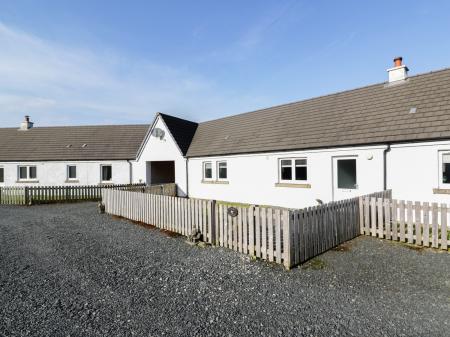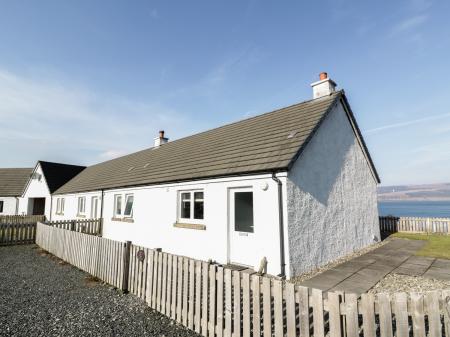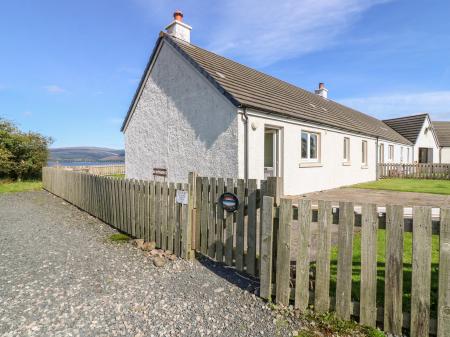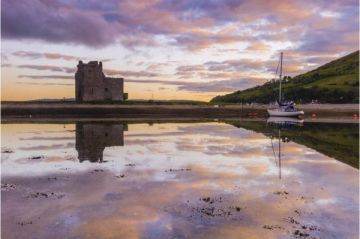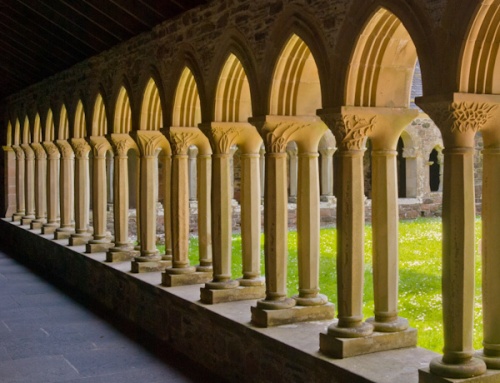
History
The island of Iona was settled long before Columba arrived in AD 563. There is a Bronze Age burial mound, and evidence of an Iron Age hillfort. The Iron Age inhabitants also built the Vallum, or earthwork enclosure, that surround the site of Columba's 6th-century monastery.
Columba came to Iona from Dal Riata, the ancient Gaelic realm that took in much of what is now western Scotland. He arrived with a dozen followers, landing at Columba's Bay on the island's southern tip. About 50 cairns stand on one of the two beaches on the shore of the bay, probably erected by medieval pilgrims emulating Columba.

St Columba's Shrine (right)
The Golden Age
Columba set up a monastic community with his followers, with a church, guesthouse, sleeping quarters, workshops, gardens, and a scriptorium. It was in the monastic scriptorium that the famous illuminated manuscript known as the Book of Kells was produced around AD 800. Columba also set up a small writing hut on the hill above the church.
The most obvious remnant of this first abbey is the high ditch, or vallum, that is still visible in sections around the abbey site. Much of what we know about the abbey and Columba's life there comes from his biographer, Abbot Admomnan, who wrote in the late 7th century.
St Columba's monastery quickly gained a reputation, not just as a centre of Christianity, but as an artistic and intellectual centre. People journeyed from across Europe to visit Iona, but at the same time, Columba and his followers travelled throughout the Scottish Highlands, spreading Christianity among the Pictish inhabitants.
Monks from Iona, led by St Aidan, converted the Northumbrian kingdom to Christianity around AD 630, by which time pilgrims were coming to Iona to visit Columba's shrine. King Oswald of Northumbria was one of those early pilgrims.
Iona was held in such high esteem that kings of Dal Riata and clan chiefs from across the Highlands were brought here for burial. It seemed that this small island was a shining beacon of learning, the arts, and spirituality, but that beacon was about to be dimmed in brutal fashion.

and the abbey church
The Vikings Arrive
In AD 795 a fleet of Norse ships descended upon Iona. The Vikings killed the monks and bore away the abbey's treasures. The monks tried to rebuild, but the Vikings returned again and again, and in AD 830 they killed 68 monks.
One effect of the Viking raids was that the monks established a new community at Kells, in Ireland, which was safe from Norse attack at that time. The Book of Kells, among other treasures, was taken for safety to Kells, and in AD 849 Columba's relics were taken from Iona for safety. Some of the relics went to Kells, others to Dunkeld, in Perthshire.
Yet for all the Viking raids, the abbey did not die, and we have records of abbots into the 11th century. Kings of the Gaelic kingdoms continued to be brought to Iona for burial.
In a peculiar twist of fate, some of the Vikings settled in western Scotland and became Christian, and so even Viking chiefs are buried at Iona. One notable Norse king, Olaf Sihtricsson of Dublin, became a monk at Iona. The grave slabs of Viking warriors are among the carved memorials in the abbey museum, and one famous stone shows a Viking longship.
The Benedictine Abbey
By the mid-12th century, Iona formed part of the lordship of the Isles, ruled by Somerled, the first king of the Isles. It was probably Somerled who founded St Oran's Chapel. Just before he died, Somerled tried to re-found Iona at the head of a chain of monasteries stretching through Ireland.
It was left to Somerled's younger son, Ranald, to re-establish the abbey, however. In 1200 AD Ranald brought in Benedictine monks, and at the same time established an Augustinian nunnery a short distance from the abbey.
Ranald's descendant John MacDonald became the first 'official' MacDonald Lord of the Isles in 1354. Subsequent lords of the Isles lavished gifts on Iona, and four of them were buried at St Oran's Chapel. The Benedictines built a grand new church on the site of Columba's original church, with a cloister and living quarters attached.
The abbey flourished throughout the medieval period, and once more welcomed pilgrims from across Europe to St Columba's shrine. In fact, in 1428 the abbot sought permission from the Pope to grant an indulgence of 3 years in Purgatory for any pilgrim visiting Iona on Columba's feast day (9 June).

In 1494 the crown finally crushed the Lordship of the Isles, so Iona lost its most important patrons. Then the Reformation took hold, and the abbey was dissolved, and the abbey church was allowed to decay.
But the Scottish Crown did not forget the importance of Iona; in 1609 James VI gathered 9 Highland clan chiefs to the island and forced them to sign the Statutes of Iona, effectively ending Gaelic separation from the Lowlands of Scotland. James's son, Charles I, made the abbey a cathedral for a new diocese of the Scottish islands, but this was a short respite, and the abbey fell into ruin by the end of the 17th century.
Restoration
Finally, in 1874 the 8th Duke of Argyll took a hand and commissioned architect Robert Anderson to repair the decrepit abbey ruins. In 1899 the abbey, nunnery, and St Oran's Chapel and burial ground were transferred to a new organisation, the Iona Cathedral Trust. Restoration began in 1902, and was completed in 1910.
Another transformation of Iona took place in 1938, when Rev George MacLeod established the Iona Community, bringing ministers in training together with unemployed craftsmen from Glasgow to work together on restoring the abbey cloister. In 2000 the nunnery, abbey, St Oran's and St Ronan's parish church were passed to Historic Scotland, while the National Trust for Scotland owns much of the island itself.
WHAT TO SEE
The Iona High Crosses
One of the highlights of visiting Iona is the chance to see four Celtic 'high crosses'. These extraordinary crosses are among the finest pieces of pre-medieval art in Europe.
The crosses are dedicated to St John, St Oran, St Matthew, and St Martin. A replica of St John's cross stands outside the abbey church, and is recognisable for the astonishing size of the cross head and arms. The replica is made of concrete but exactly duplicates the original cross. This cross is located so that in the late afternoon its shadow falls on the doorway of St Columba's Shrine.
The original St John's cross can be viewed in the abbey museum, where you can also find St Matthew's Cross and St Oran's Cross. The latter originally stood outside St Oran's Chapel, a short distance from the abbey. St Oran's and St Matthew's crosses had lain in broken sections for years, but have now been reassembled like jigsaw puzzles and mounted so they can stand upright.
St Martin's Cross still stands in front of the abbey, as it has done for over 1000 years. This amazing piece of Celtic sculpture is carved from a solid block of granite. One face shows Biblical scenes, while the other is carved with writhing serpents and bosses in relief.


The Abbey Museum
Behind the abbey is a museum showcasing a wealth of historic objects found on Iona and the surrounding area. The prize exhibits are the three high crosses mentioned earlier (St Oran's, St Matthew's, and St John's). One fascinating exhibit is a replica of the Book of Kells, an illuminated manuscript depicting the Four Gospels, created on Iona around 800 AD.
The major focus of the museum is a series of wonderfully carved grave slabs from early Christian to the late medieval period. The earliest of these stones date to the Viking period, but most are from the 14th to the 16th centuries. The grave slabs commemorate West Highland warriors and are quite wonderfully detailed.
The masons of Iona had their own unique style, and this 'Iona School' of carving was copied throughout the West Highlands. More grave slabs are set up around the cloisters. Some were carved at the abbey, while others were carved locally and brought to the abbey when a chief was carried to Iona for burial.



The Abbey Church
Though the medieval church has been rebuilt multiple times, enough of the original medieval architecture remains to create a fascinating and ultimately moving experience.
The nave is the most obviously restored part of the church, but the lowest part of the west wall is 13th century, and the west door is 15th century. Late medieval grave slabs to 5 clerics are set along the south wall. The best surviving part of the original 12th-century church is the north transept, with Romanesque arches and simple single lance windows.
The capitals of the 15th-century crossing arch are wonderfully carved with animals, foliage, and human figures, including both Biblical stories and scenes from daily life. One fascinating carving shows 3 men about to sacrifice a cow. A carved face on the arch may be the mason responsible for the work; an Irishman named Donald O Brolchan.
In the south transept are marble effigies of the 8th Duke of Argyll and his wife, Ina MacNeill. Only the Countess is actually buried at Iona; the Duke is interred in his family burial ground in Dunoon.
The choir is built on two levels; the result of a mid-13th century extension. The result is a peculiar jumble of architectural bits and bobs, including arches that begin halfway up the north wall. Look for the wonderfully carved three-seat sedilia. Either side of the altar are medieval effigies. One is Abbot Dominic (1421–65), the other is Abbot John MacKinnon (1467–98), son of the MacKinnon clan chief.

and the sedilia
The Abbey Cloisters
The layout of Iona Abbey follows a traditional monastic layout, with a cloister walk adjoining the church, although in this case the cloister is unusually sited on the north side of the church. Very little remains of the original medieval cloisters; what we see today was rebuilt in the 1950s and 60s.
Though modern, the cloister is magnificently carved to resemble an authentic medieval cloister experience, with double rows of columns supporting capitals carved with flowers and birds. At the centre of the cloister garth is a modern sculpture by Jacob Lipchitz, called Descent of the Spirit, an expression of hope for better human understanding.
Around the outer cloister wall is an array of medieval grave slabs. Many of these originally stood outside in St Oran's Chapel burial ground. The carving is magnificent, with common motifs including flowers, swords, and hunting scenes. Many of the slabs commemorate clan chiefs, including many MacKinnon, MacLean and MacLeod chieftains. More grave slabs are on display in the abbey museum.



in the cloister
St Columba's Shrine
A small gabled shrine beside the church is known as St Columba's Shrine and marks the traditional spot where Columba's remains were enshrined after his death in AD 597. Though the upper walls and roof were rebuilt in the 20th century, the lower sections of walls are thought to be of 7th-century date, so may have formed part of the original shrine. The Road of the Dead led to the door of this shrine, not to the abbey itself.

and the shrine entrance
Road of the Dead
Leading to the abbey from St Oran's Graveyard is a wide cobbled track known as the Road of the Dead. This is just a small section of an early processional way built to mimic the Via Dolorosa in Rome. The road originally extended all the way to the Port of the Martyrs (Port nam Mairtear), where the ferry pier now stands. The coffins of chiefs would be carried from the port, along a track lined with crosses, to the abbey site for burial.

leading to the shrine
St Oran's Chapel
Set apart from the abbey itself is a simple rectangular chapel, probably built by Somerled as a private burial chapel for his family. Since Somerled died in 1164 it seems very likely it was built shortly before that date. This makes St Oran's Chapel the oldest original part of the medieval abbey complex to survive intact.
Everything except the slate roof is original 12th-century work, including the beautifully carved doorway arch, with three orders of moulding in Norman chevron style.
The interior is lit by only two slender windows, which shed light on grave slabs set into the floor. The slabs mark the resting place of medieval 'Sea Kings'. In the south wall is a tomb recess under a beautiful canopied arch. No effigy rests within the niche, but we think it was made for one of the MacDonald Lords of the Isles, possibly the last Lord, John, who died in 1503.

A story associated with the Chapel is that the walls kept collapsing when being built, and the builders, deciding that a human sacrifice was needed to quiet evil spirits, buried a volunteer (Oran) in the walls.
In front of the chapel is Reilig Odhrain, or St Oran's Graveyard, where the medieval MacDonald Lords of the Isles were buried. The Lord's most powerful clan chiefs, from among the MacLean, MacLeod, and MacKinnon clans, were also buried here.
Many of these chieftain's gravestones are now in the abbey museum. In the graveyard is a large stone plinth marking the spot where the 8th century High Cross of St Oran once stood. The cross is now in the Abbey Museum. Oran was Columba's cousin and one of his first dozen followers.

Bishop's House
One wall and a few fragmentary foundations are all that remain of a 17th-century house built for Bishop Neil Campbell around 1630. The ruins stand at the northern end of the abbey site. We can see enough of the building foundations to tell that it had a large living area at one end with a kitchen at the other. Above the kitchen was a small sleeping area, while the living area was open to the roof.

St Mary's Chapel
One of the least complete of the abbey buildings, this fragment of wall stands to the southeast of the abbey church. It once formed part of a 13th-century chapel.
Michael Chapel
Built around 1200, probably as a temporary place of worship for the Benedictine monks before their new church was built. The chapel was reconstructed around 1500 and restored in the 20th century. The stalls and ceiling are built of African timber, a reminder that most of the 20th-century restoration money came from African donations.
The Vallum
A pair of earthwork banks with a deep ditch between them encircled Columba's original monastery. Stretches of this vallum remain, particularly a section just northwest of the abbey church. The ditch is 4 metres from its bottom to the top of the inner bank, so this was more than just a symbolic boundary.
Torr an Alba
On a hill overlooking the abbey is a small outcrop of rock. It is here that Columba is said to have his small writing hut. Written descriptions say that Columba could see Mull from his hut, and hear the sound of voices from across the water. Certainly, the Torr gives excellent views across the Sound of Mull. On the hilltop is a socket in the stone which once supported a high cross.
Also on Iona
Iona Nunnery
Near the ferry landing, and beside the visitor path to the abbey, stand the roofless ruins of a 13th-century nunnery founded by Reginald, son of Somerled, Lord of the Isles, who also re-founded the abbey at the same time. Interestingly, the abbey was a Benedictine house, while the nunnery was founded for the Augustinian order. The first abbess was Bethoc, Reginald's sister.
Iona Nunnery was popular among noble women of Argyll as a place to retire and live out their years in relative peace. The best surviving part of the nunnery is the church, which has beautifully carved arcade capitals. On the same site is an 8th-century chapel, which has now been restored and serves as a museum of artefacts found on the nunnery site.

MacLean's Cross
Apart from the high crosses at the abbey itself, there is another, equally fascinating, cross on Iona. This is the late 15th-century MacLean's Cross, which stands beside the 'Street of the Dead' where it joins the main visitor path from the ferry landing to the abbey site.
MacLean's Cross stands over 3 metres high and is carved from a single block of granite in the traditional 'Iona School' style, with intricate foliage and geometric plaitwork on both sides. Near the cross base is a carving of a horseman, perhaps depicting the MacLean chief who paid for the cross.

Visiting Iona
Getting There
Since Iona is an island, access is only by boat, and the simplest place to get a boat is from Fionnphort, on the westernmost tip of the Ross of Mull. Fionnphort is separated from Iona by a narrow channel, so a boat trip is quite short, and services run daily throughout the year.
But - and its a big but - if weather is foul the boat ferry can be cancelled at a moment's notice for safety reasons, so it is always a good idea to keep a close eye on weather forecasts before visiting or contact the ferry operators CalMac directly for the latest updates.
You can't reserve a sailing ahead of time, which is actually to your benefit, as you'd hate to reserve a sailing then have it cancelled at short notice. Tickets can be purchased onboard or at the CalMac office in Phionnphort. Note that you can't bring vehicles to Iona; it is foot traffic only. You'll have to leave your car in the parking area at Fionnphort.
Sail Boat Hire
I'll conclude this article with a bit of a recommendation. If you have time after exploring the abbey, nunnery, St Columba's cell, the high crosses, and all the other wonderful historic features that make Iona so enjoyable, why not do what our family did and take a short sailboat 'cruise' around the island?
We joined a sailboat excursion at the ferry jetty, and for a very reasonable fee, we had a lovely couple of hours sailing around the island, learning about the history of the various bays and points of the island, and soaking up the sun and spray. The scenery was stunning, and we all got to try our hand at sailing the boat ourselves, with expert guidance. It was enormous fun, and I can highly recommend the experience!










 We've 'tagged' this attraction information to help you find related historic attractions and learn more about major time periods mentioned.
We've 'tagged' this attraction information to help you find related historic attractions and learn more about major time periods mentioned.